Branding Strategies: Building Impactful Small Businesses

Explore this brand strategy software comparison featuring 8 tools to streamline your branding efforts and enhance your business strategy in 2025.

Choosing the right branding and marketing solution can change the way a business connects with its audience. Some tools help you bring a fresh identity to life. Others give teams the power to control every detail of their brand or build a loyal community around their work. With so many options promising simplicity, efficiency, or creative freedom, it is easy to wonder what makes each one different. The right choice could help you turn ideas into reality, reach more people, and keep your message consistent as you grow. Whether you are an entrepreneur or part of a large team, discovering how these platforms work may spark new ideas for your next big step.

Reasonate Studio is a boutique brand and marketing consultancy that helps founders and small teams move from fuzzy ideas to focused, revenue-driving brands. Based in Austin, TX, the studio uses its proprietary Aligned Impact Model™ to map brand foundations and convert them into repeatable marketing systems. If you need clarity, emotional connection, and a plan you can actually execute without hiring an army, Reasonate is built for you.
Reasonate combines strategy and execution: a proprietary framework (the Aligned Impact Model™) that diagnoses brand gaps and prescribes a clear roadmap, brand strategy development to lock down positioning and values, messaging and voice shaping to make your copy and content resonate, marketing and content planning to align channels with goals, and marketing systemization to improve workflow and consistency. The approach blends creative storytelling with operational discipline so your messaging doesn’t just look good—it converts.
Reasonate is ideal for early-stage entrepreneurs, side-hustlers ready to go full-time, service-based business owners, and small teams (founders and business owners) seeking strategic clarity rather than a one-off logo. If you’re focused on building authentic connection, improving client acquisition predictability, and creating marketing systems that scale without wasting ad spend, this studio is a fit.
Reasonate’s unique advantage is the Aligned Impact Model™—a proprietary, step-by-step framework that converts abstract brand intent into measurable marketing systems. Unlike consultancies that deliver reports and leave you with ambiguity, Reasonate pairs strategic diagnosis with tactical implementation (DIY, DWY, DFY tiers) so you walk away with both clarity and a functioning engine for growth. This design choice—prioritizing sustainable systems over flashy, short-lived solutions—makes it superior for founders who need reliable, repeatable outcomes rather than marketing theater. In short: you get a strategic partner who builds the roadmap and helps you drive the car.
A local Austin business engaged Reasonate to clarify brand voice, deeply define target audiences, and launch an integrated campaign. The result: clearer messaging across channels, smoother internal workflows for content, and measurable increases in awareness and customer engagement driven by aligned strategy and execution.
Not specified on the website.
Website: https://reasonatestudio.com
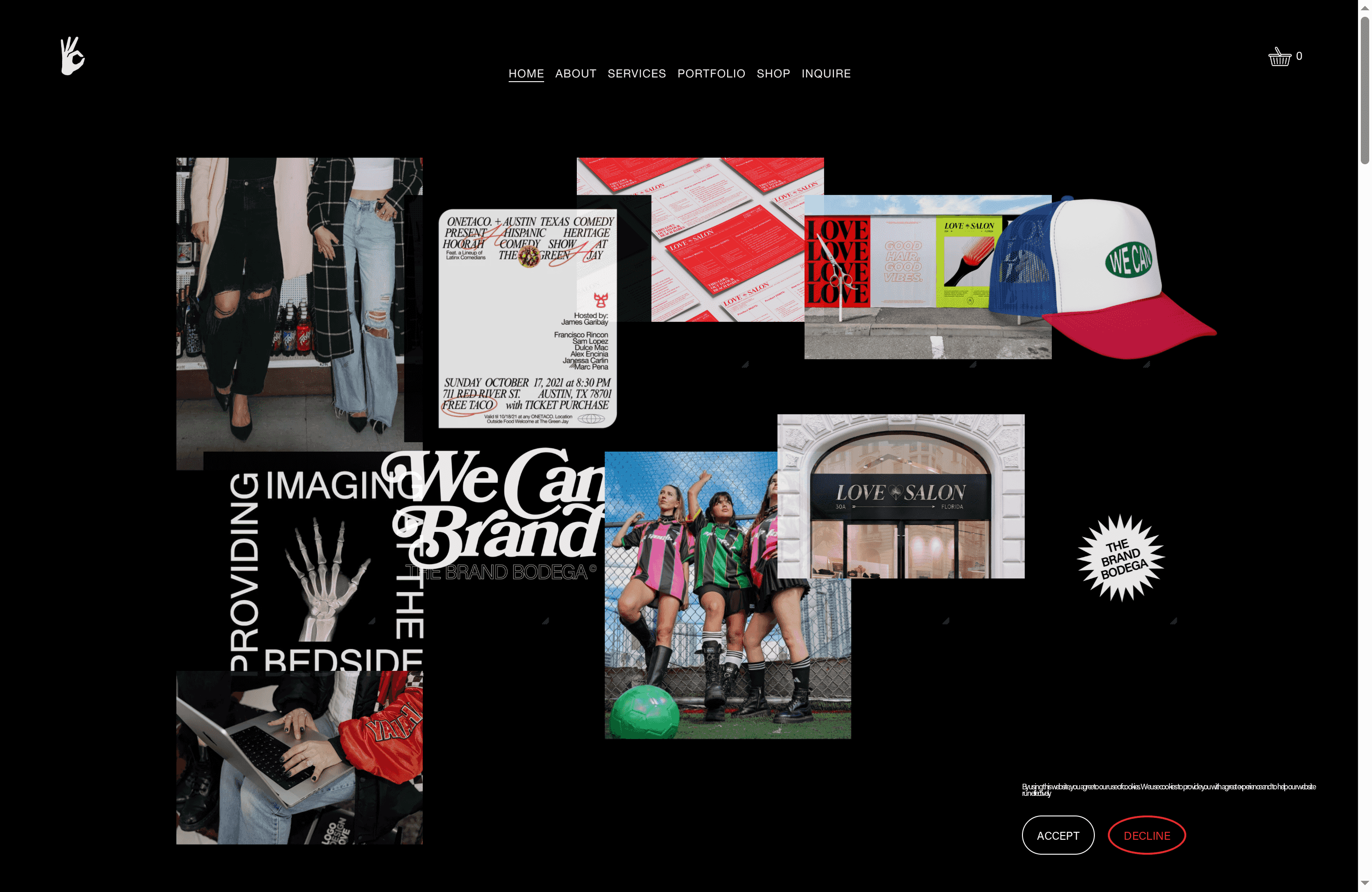
We Can Brand is a female-led creative studio based in Austin and Waco that combines empathy-driven strategy with disruptive design to help small brands stand out. They offer end-to-end branding and marketing services—from identity and web design to social content and merch—delivered through a personalized, non-template approach. If you want a boutique partner who prioritizes authentic voice and scalable strategy, this studio is a strong fit; just be prepared to ask for a quote because pricing isn’t listed publicly.
We Can Brand focuses on full-spectrum creative and strategic services: brand identity and content creation, digital and print design, social media management, web development and creative direction, and integrated marketing strategies. Their process centers on close collaboration, translating a client’s vision and values into visual systems and content that can scale across platforms and physical products like merchandise and apparel.
We Can Brand fits startups, service-based founders, and small companies that value a strategic, creative partnership and want a distinct visual identity that feels authentic. If you prefer working directly with a small, empathetic team and need design plus content that can scale into marketing and merch, this studio is crafted for you.
Their unique edge is a human-first branding process that blends disruptive design with scalable strategy—delivered by a female-led team that emphasizes authentic voice and personalized collaboration. That combination aims to produce work that’s both emotionally resonant and operationally useful.
A small Austin startup hires We Can Brand to craft a visual identity, build a conversion-focused website, and deploy a social content plan with branded templates and merchandise concepts—resulting in a cohesive presence that resonates with local customers and supports early growth.
Not specified on the website. Expect quote-based pricing after consultation.
Website: https://wecanbrand.co
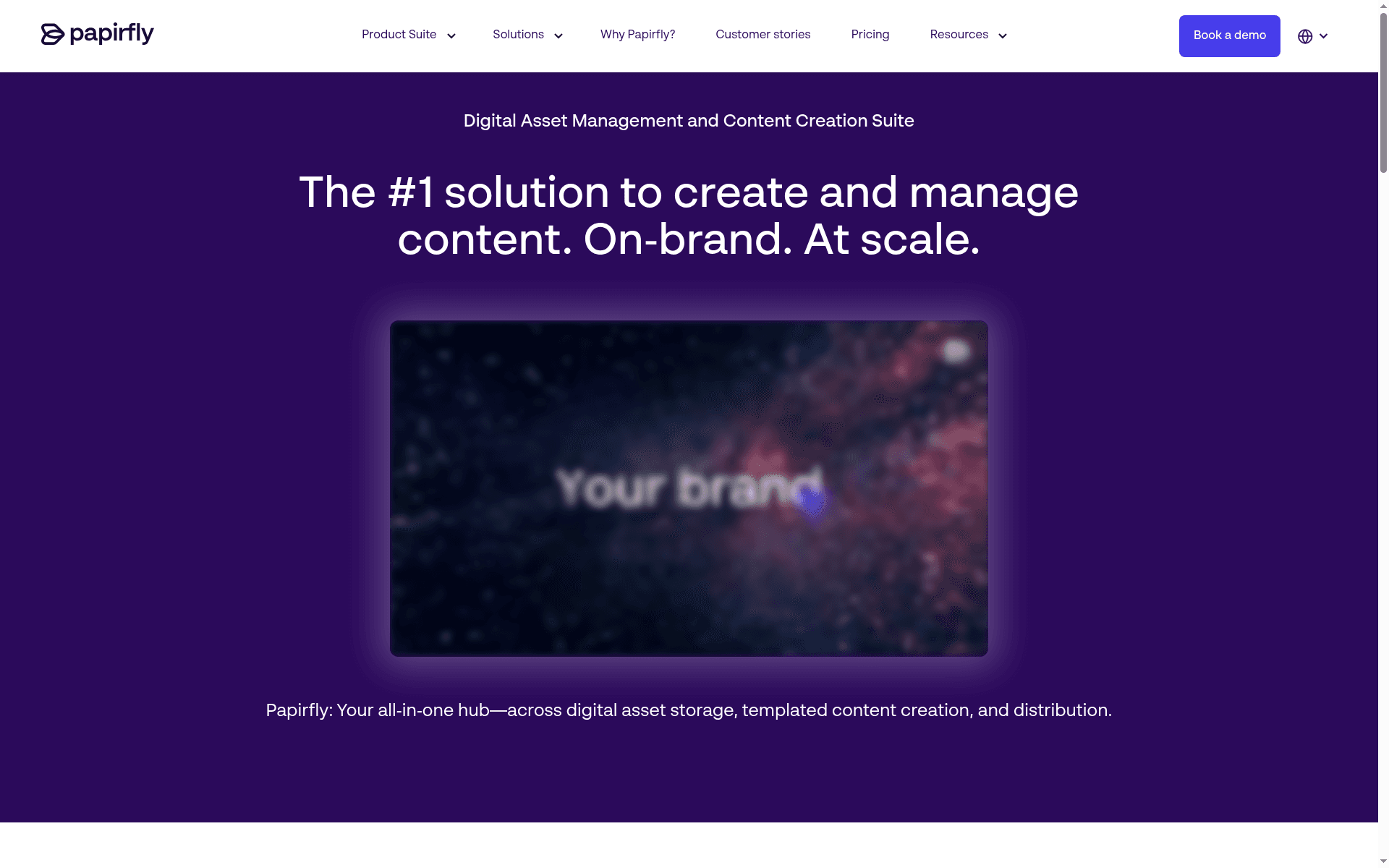
Papirfly Suite is an all-in-one digital asset management (DAM) and templated content creation platform built to help organizations scale branded content and keep control across teams and regions. It combines DAM, templated creation, workflow management, and distribution into a single platform so brands can produce consistent assets faster. If you need centralized brand control and repeatable content production across locations, Papirfly is clearly designed for that purpose — but expect a customization and consultation process to get the full value.
Papirfly’s core capabilities center on a unified platform that links digital asset storage, templated content creation, and campaign distribution workflows. The DAM lets you store, tag, and retrieve assets efficiently; templated creation enables non-designers to produce on-brand materials; workflow management governs how assets move through approval and distribution; and locked-down templates empower local teams while protecting brand standards. The result is a system engineered to reduce tool fragmentation and standardize output across channels.
Papirfly Suite is best suited to brands and organizations that require a centralized, enterprise-style solution for managing digital assets and producing templated content at scale. If you run marketing for a multinational, a franchise network, or any operation with distributed teams that must follow strict brand rules, Papirfly is aimed at you. Small solo founders or early-stage hustles may find the consultation and customization overhead disproportionate.
Papirfly’s unique value is its end-to-end alignment of DAM, templated creation, and distribution workflows in one platform — designed to keep brand consistency while enabling high-volume, local-friendly content production. It’s less a point tool and more a governance engine for brands that can invest in tailored setup.
A multinational uses Papirfly to centralize every brand asset, provide country teams with locked templates, and distribute campaign materials across channels. The central brand team retains control while local markets churn out compliant, localized content quickly, dramatically reducing approval cycles and production friction.
Quote-based. Custom, based on tailored solutions and modules needed.
Website: https://brandmaster.com

Frontify is a purpose-built brand management platform that centralizes digital assets, guidelines, templates, and collaboration for distributed marketing teams. It’s designed to enforce consistency at scale while offering customization through apps, content blocks, and integrations. If you run brand operations across markets or work with external agencies, Frontify removes a lot of manual friction—but it’s not a plug-and-play, low-cost solution for solo founders. It rewards organizations that invest time in setup and integration.
Frontify’s core capabilities center on Digital Asset Management (DAM), branded guidelines and portals, reusable templates, and collaboration/workflow tools that keep distributed teams aligned. The platform supports integrations with other software platforms, a marketplace for custom apps, content blocks, and themes, and enterprise-grade security like SSO and granular permissions. Together, these features create a single source of truth for assets and rules, while allowing customization and automation to fit existing processes.
Frontify is best suited to large enterprises, global marketing teams, and agencies that need formalized brand operations and strict governance across many markets. If you manage multiple product lines, global campaigns, or external creative partners, Frontify scales to those complexities. Solo founders and micro teams will likely find it more platform than they need unless they anticipate rapid expansion.
Frontify’s unique strength is combining a robust DAM with enforceable brand portals and enterprise security, packaged in a customizable ecosystem that integrates into broader workflows. That combination turns brand guidelines from static documents into living, actionable systems that reduce errors and speed production across teams and partners.
A multinational corporation centralizes logos, campaign assets, and tone-of-voice guidelines in Frontify, then shares scoped portals with regional teams and external agencies. The result is tighter control over how the brand appears in different markets, fewer off-brand executions, and measurable improvements in team efficiency.
Quote-based (MAU model; contact sales for tailored packages).
Website: https://frontify.com

Corebrand AI is a consultancy-backed AI platform focused on marketing and customer experience (CX). Its Foresight product combines predictive analytics, machine learning, and NLP to help brands measure performance, predict customer behavior, and manage complexity at scale. If you need tailored AI-driven insights and are prepared to invest in implementation, Corebrand AI can move the needle; if you need a plug-and-play tool, it may demand more resources and adaptation.
Corebrand AI centers on predictive analytics for marketing and CX, delivering high-impact insights at scale through machine learning and natural language processing (NLP). The platform emphasizes brand performance measurement and visibility and is supported by data science expertise and consulting services to translate models into business decisions. Their Foresight offering is designed to help brands track performance, detect anomalies, and predict outcomes across customer journeys.
Corebrand AI is best suited for organizations that want to leverage advanced analytics and AI to improve marketing outcomes and customer experience, particularly those seeking customized solutions supported by consulting and data science. It fits brands that have some data maturity or the willingness to invest in implementation and process change to realize AI-driven insights.
Corebrand AI’s unique value lies in pairing a purpose-built analytics platform (Foresight) with hands-on consulting and data science expertise, which helps teams turn predictive models into measurable business actions. That blend—technology plus people and process—aims to reduce complexity and increase the likelihood that insights translate to improved CX and marketing performance.
A client used Corebrand’s sentiment analysis to extract themes from customer reviews and conversations across channels, improving real-time understanding of customer sentiment and behavior and enabling faster, evidence-based adjustments to messaging and service.
Not specified on the website
Website: https://corebrand.com
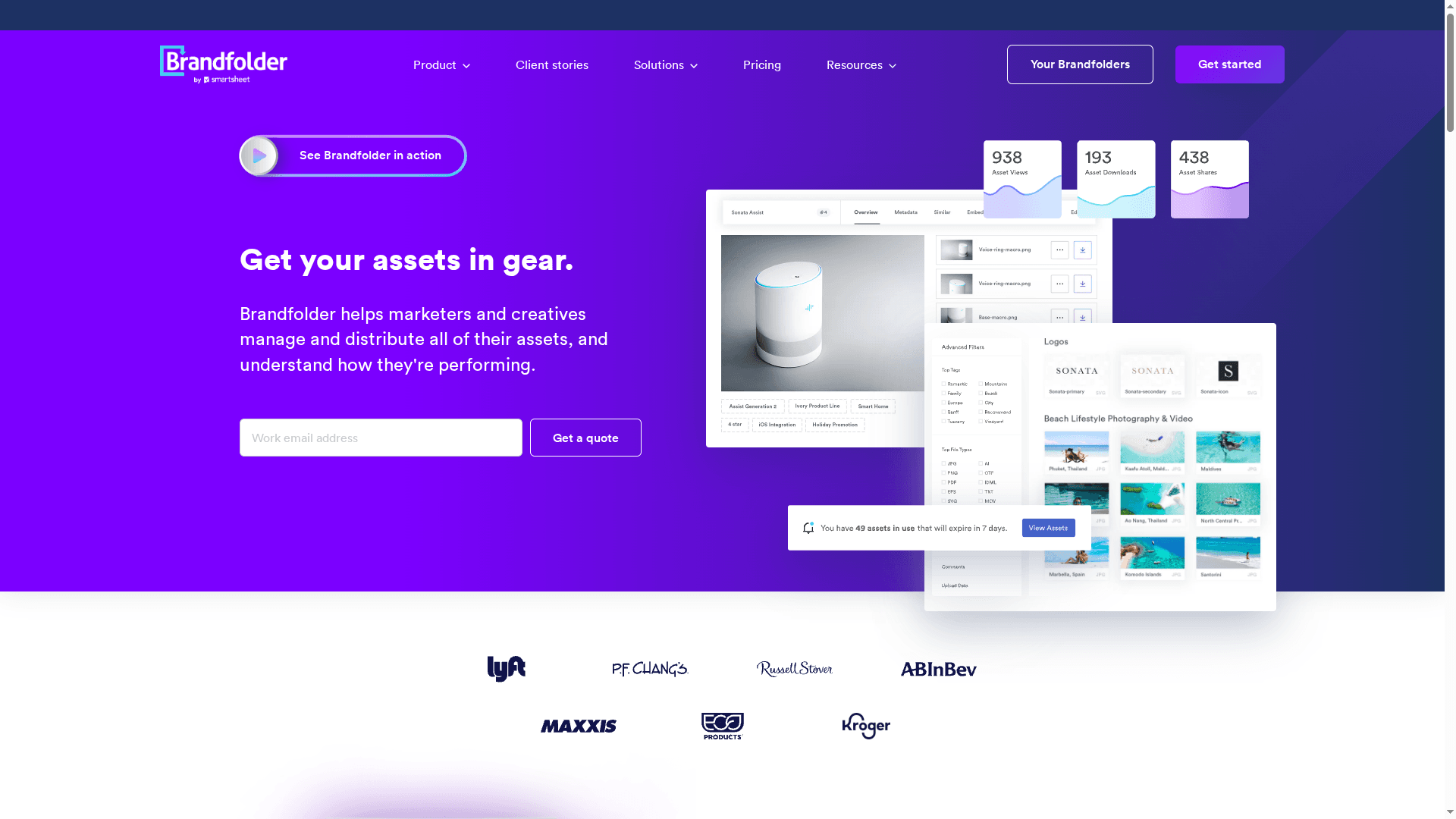
Brandfolder is a cloud-based digital asset management (DAM) platform built to make asset storage, distribution, and performance measurement straightforward for marketing and creative teams. It centralizes brand assets into a single source of truth with intuitive search and permissioning, while feeding analytics that show how assets perform across channels. For teams that need scalable control and insight, Brandfolder delivers enterprise-grade capability with a user-friendly surface—though small teams should be prepared for setup work and potential training to unlock advanced features.
Brandfolder’s core capabilities focus on discoverability, governance, and insight. It provides an easy-to-use asset search and access layer, distribution controls with privacy and permissioning, and performance analytics that surface which assets drive engagement. Automated tagging and duplicate detection speed organization, and integrations plus custom branding let you fold Brandfolder into existing workflows. In short: it’s a DAM designed to be the operational backbone for asset-heavy marketing programs.
Brandfolder suits organizations that produce and distribute lots of digital content—marketing teams, creative agencies, and enterprises with regional markets. It’s ideal if you need strict brand governance, multi-market distribution, or analytics to prove asset ROI. Smaller businesses can benefit but should budget time and possibly vendor support for implementation.
Brandfolder combines enterprise-grade governance with an approachable interface, pairing automated organization with analytics so teams can both control and measure assets from one place. That mix of ease-of-use plus operational depth is its standout promise.
Teams use Brandfolder to centralize creative libraries and push approved assets to channels and regional teams; for example, P.F. Chang’s manages assets across 23 global markets, Russell Stover distributes assets across channels to streamline collaboration, and Conga reported $300,000 in annual software cost savings after adoption.
Quote-based: Pricing plans include Premium, Enterprise, and custom options; specific costs are available upon request or demo.
Website: https://brandfolder.com
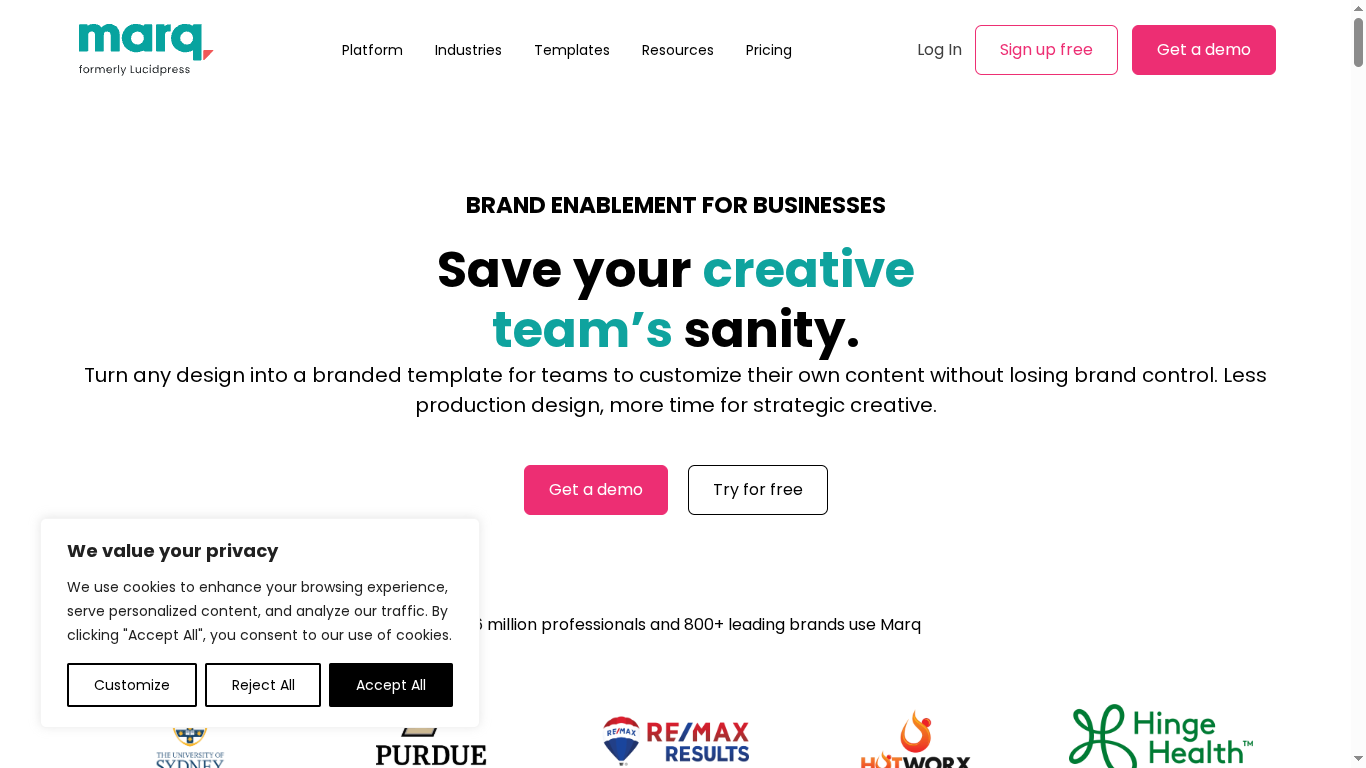
Marq is a brand enablement platform built to keep your content on-brand while accelerating production. It combines design import, templating, personalization, and multi-channel distribution so teams can create and share branded materials without constant designer intervention. Bottom line: Marq reduces creative bottlenecks and enforces brand standards, making it a practical choice for teams that need consistent, repeatable content at scale.
Marq’s core capabilities center on templated design and controlled customization. You can import designs or build directly in the editor, lock essential brand elements to prevent off-brand edits, and distribute finished assets to social, print, or email channels. Template locking and shared templates give marketing leaders control while letting non-designers personalize content for local or campaign-specific needs. Overall, the platform focuses on brand control, speed of execution, and broad content distribution.
Marq is a fit for organizations of all sizes that need to streamline brand content creation and maintain consistent standards across teams. For early-stage entrepreneurs and service providers, it offers a way to produce on-brand materials without hiring a full-time designer. For small growing companies and marketing teams, it reduces bottlenecks and hands more control to non-design staff. For established brands, it enforces compliance across distributed teams.
Marq uniquely blends centralized brand control with editable templates, letting you lock critical design elements while still enabling local customization. That balance—control without paralysis—lets teams scale content production without sacrificing brand standards.
A marketing team at a real estate company uses Marq to create customizable templates for property listings, flyers, and agent-branded materials, saving hours per listing and ensuring every asset meets corporate brand guidelines.
Details not provided in the content.
Website: https://marq.com
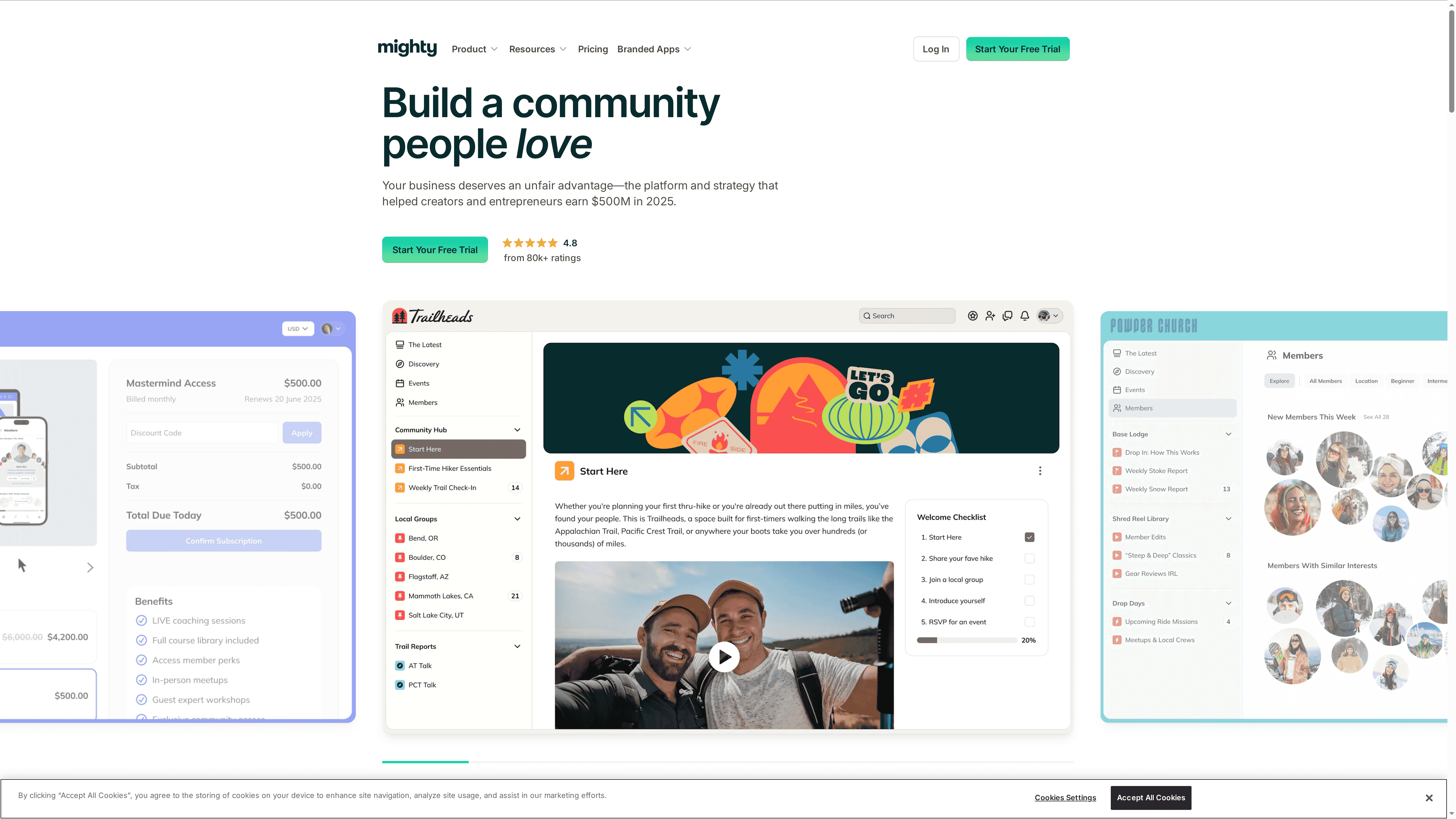
Mighty Networks is a purpose-built community platform that combines courses, memberships, events, and monetization tools into one place. It’s designed to help creators, entrepreneurs, and brands build active, revenue-generating communities with built-in analytics, automation, and branding control. For founders and solo creators who want to move beyond scattered tools, Mighty Networks offers a unified option — but it comes with a learning curve and price considerations for very small operations.
Mighty Networks bundles community-first features around member activity and content monetization: courses and challenges, events and livestreaming, a members activity feed, and gamification to boost engagement. It also provides landing pages, payment processing, embed options, integrations, automations, admin and management tools, and analytics — essentially the operational stack you need to run paid memberships and live programming without stitching multiple services together.
Mighty Networks is best for creators, entrepreneurs, and brands that want to centralize community, content, and commerce in one environment. If you’re building paid memberships, running cohort courses, or hosting frequent live events and need a platform that scales with engagement, this is a solid choice. If you’re a lean side-hustler with minimal budget and zero tolerance for setup time, you may find it heavy-handed.
Mighty Networks’ core value is consolidation: it replaces disparate community, course, and payment tools with a single platform focused on engagement and monetization. That unified approach saves time, preserves brand experience, and provides analytics that connect member activity to revenue — a clear advantage for creators aiming to professionalize their offerings.
A creator launches a paid membership with exclusive content, cohort-based courses, and a community chat. They use Mighty Networks to host course materials, run live events, automate onboarding, and process subscription payments — engaging members in one branded environment while turning audience loyalty into steady income.
Starting at $49/month for the Community plan, with custom pricing for Pro services and branded apps.
Website: https://mightynetworks.com
This table compares various branding and marketing tools, highlighting their core features, pros, cons, ideal users, pricing, and unique value.
| Product | Core Features | Pros | Cons | Ideal For | Pricing |
|---|---|---|---|---|---|
| Reasonate Studio | Aligned Impact Model™, brand strategy, marketing systemization | Trusted by 100+ businesses, impactful branding, customized strategies | Pricing not specified | Early-stage entrepreneurs, small teams | Not specified |
| We Can Brand | Empathy-driven design, end-to-end branding, personalized approach | Values-driven leadership, comprehensive services, direct client engagement | Limited pricing transparency, narrow geographic footprint | Startups, service-based founders | Quote-based |
| Papirfly Suite | DAM, templated creation, workflow management | Integrated platform, ease of use, brand consistency | Complex pricing, requires consultation | Large organizations, brands | Quote-based |
| Frontify | DAM, branded guidelines, templates, collaboration tools | Centralized platform, strong security, enhances brand consistency | Price varies with active users, requires setup | Large enterprises, marketing teams | Quote-based (MAU model) |
| Corebrand AI | Predictive analytics, ML and NLP for marketing | Custom AI solutions, integrated approach, data science expertise | Resource-intensive, marketing and CX focus | Organizations leveraging AI for marketing | Not specified |
| Brandfolder | Asset storage, distribution, performance metrics | Operational efficiency, collaboration, performance insights | Limited pricing transparency, requires setup | Marketing teams, creative agencies | Quote-based |
| Marq | Templated design, controlled customization, multi-channel distribution | Ensures brand consistency, speeds content creation, empowers non-designers | Potential learning curve, no pricing details | Organizations needing streamlined content creation | Not specified |
| Mighty Networks | Community features, courses, membership monetization | High customer satisfaction, comprehensive monetization, custom branding | Complexity for new users, pricing for small operations | Creators, entrepreneurs building community-driven revenue streams | Starting at $49/month |
Many entrepreneurs and small business owners find themselves overwhelmed by fragmented brand tools that promise quick fixes but lack strategic depth. The key challenge highlighted in the Best Brand Strategy Software Comparison is cutting through the noise to build a sustainable marketing system that delivers clarity, emotional connection, and measurable growth. If you are tired of scattered campaigns that drain your budget without results or unclear branding approaches that leave your audience confused, you are not alone.
At Reasonate Studio, we understand these exact pain points through our proprietary Aligned Impact Model™. This framework guides you step-by-step from defining your brand foundations like values and positioning to aligning marketing execution with your business goals. We do more than offer software solutions; we become your strategic partner, blending coaching, creative storytelling, and operational discipline into one cohesive system. This means you can skip the guesswork, reduce wasted spend, and build a repeatable marketing engine that grows with you.
Ready to stop spinning your wheels and start making meaningful progress with your brand strategy?
Discover how Reasonate Studio can help you map your unique brand and execute with confidence today.
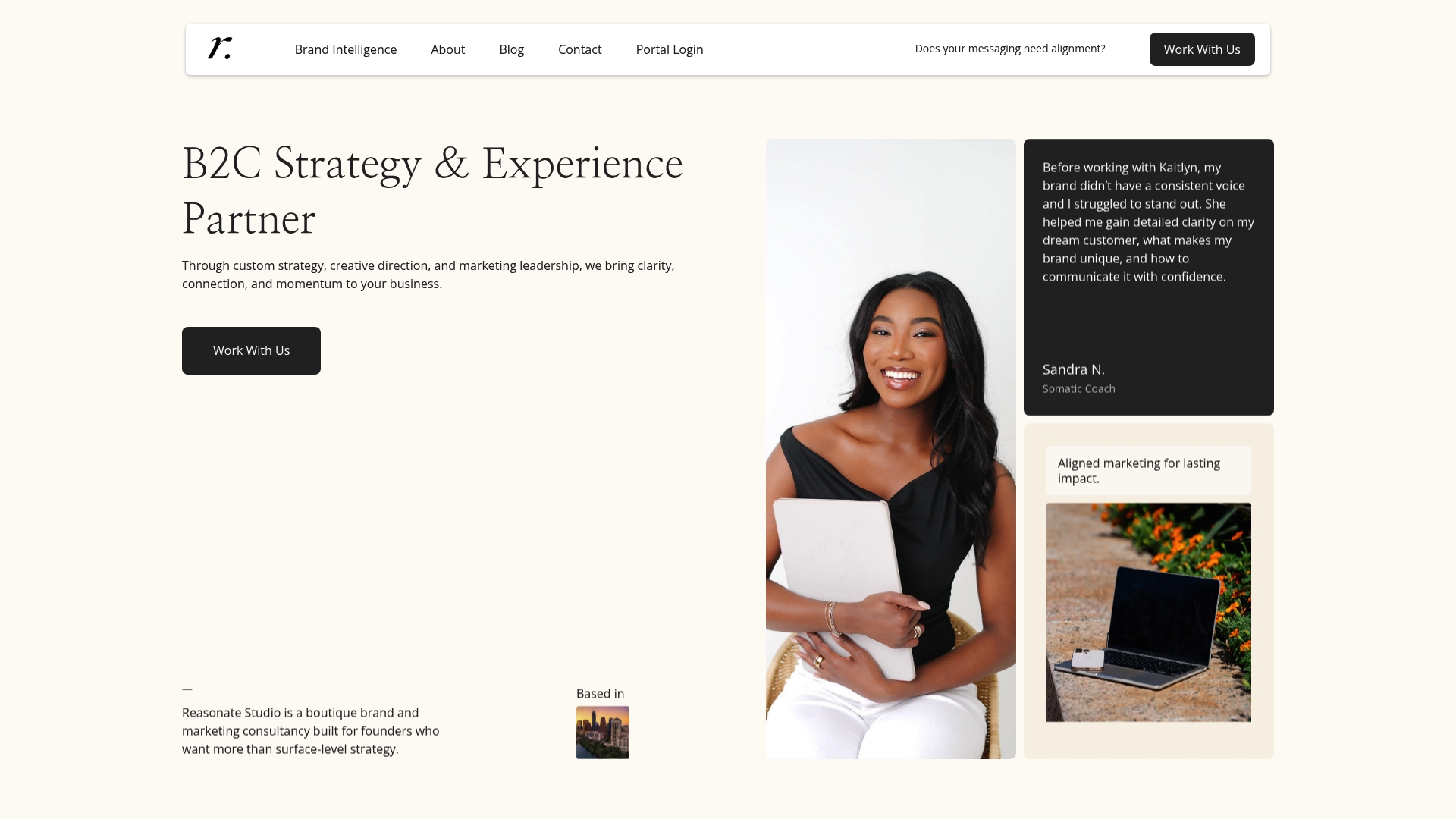
Take the next step toward clarity, focus, and sustainable growth with Reasonate Studio. Visit our landing page now to explore customized support options built for entrepreneurs like you. Your brand’s full potential is within reach when you have the right partner guiding your strategy and execution every step of the way.
To effectively manage your brand strategy, seek software that offers features like brand management, digital asset management, and workflow tools. Prioritize platforms that allow for integrated marketing campaigns and performance analytics to monitor the effectiveness of your branding efforts.
Begin by defining your specific branding needs, such as managing assets or creating marketing templates. Then, compare tools based on features, user feedback, and ease of use to determine which platform aligns with your operational requirements.
First, outline your goals and the specific challenges you aim to address. Next, train your team on the selected software and outline a rollout plan that includes timelines and key performance indicators (KPIs) to track progress within the first 90 days.
Brand strategy software enhances consistency by centralizing brand assets and guidelines, making it easy for teams to access approved materials. Use a single platform to ensure all communications and designs align with your brand standards, effectively reducing discrepancies by approximately 30%.
Evaluate the pricing structure based on your organization’s size and anticipated usage, looking for tiered pricing or customizable plans. Be prepared to assess both upfront costs and long-term value by estimating potential savings on digital asset management and other operational efficiencies.
Typically, brands can expect to see improvements in workflow efficiency and consistency within 30–60 days of implementation. Monitor KPIs closely during this period to identify areas of success and adjust your strategy as necessary.